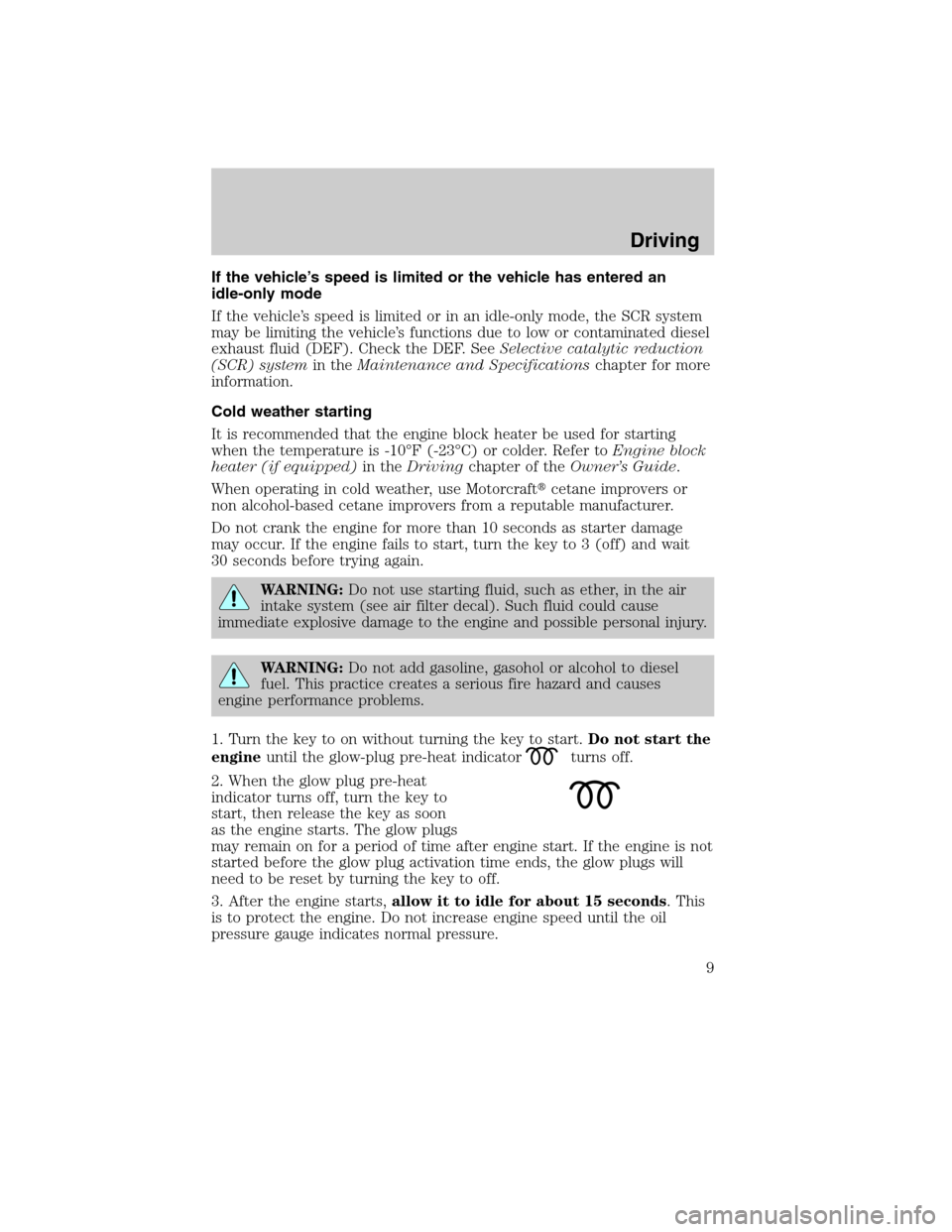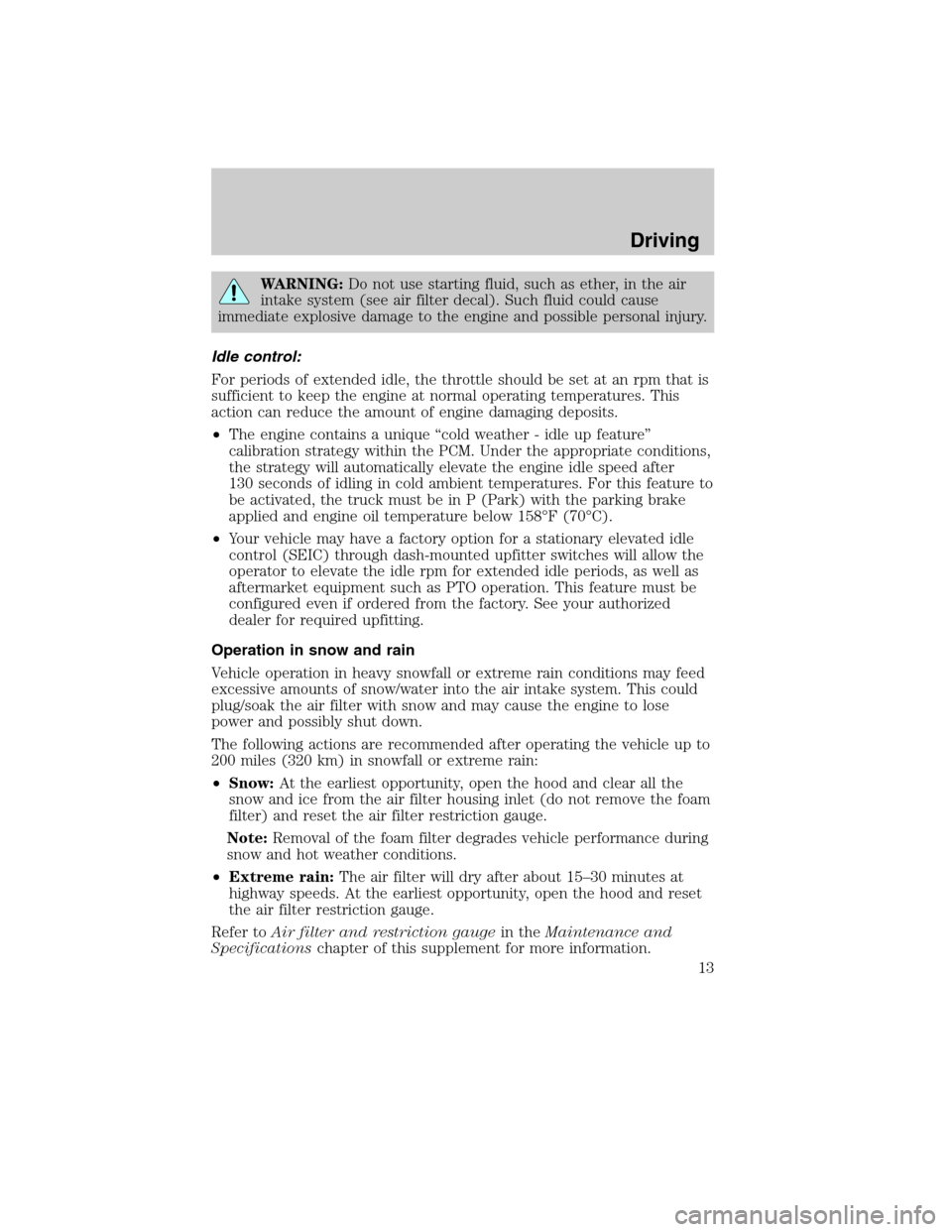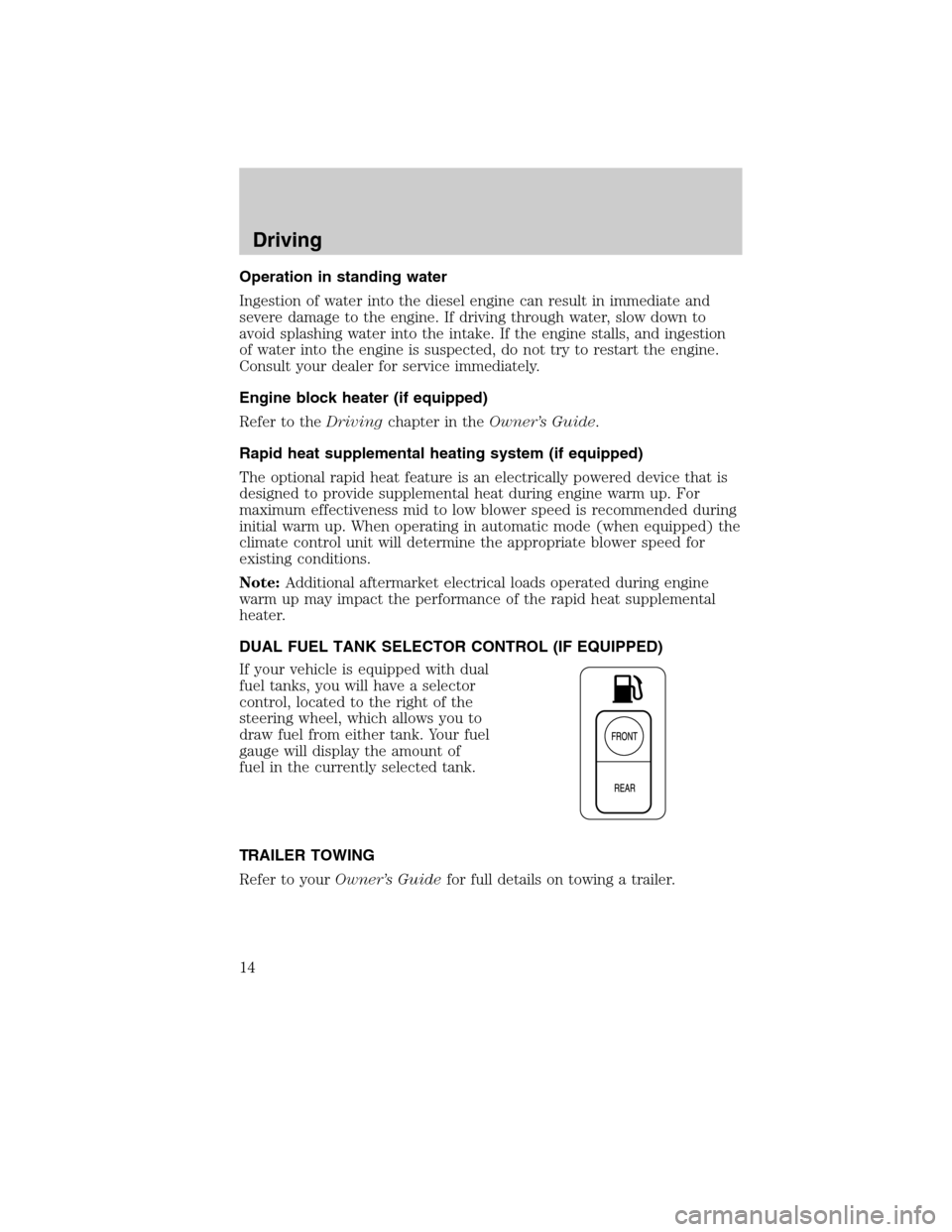Page 9 of 90

If the vehicle’s speed is limited or the vehicle has entered an
idle-only mode
If the vehicle’s speed is limited or in an idle-only mode, the SCR system
may be limiting the vehicle’s functions due to low or contaminated diesel
exhaust fluid (DEF). Check the DEF. SeeSelective catalytic reduction
(SCR) systemin theMaintenance and Specificationschapter for more
information.
Cold weather starting
It is recommended that the engine block heater be used for starting
when the temperature is -10°F (-23°C) or colder. Refer toEngine block
heater (if equipped)in theDrivingchapter of theOwner’s Guide.
When operating in cold weather, use Motorcraft�cetane improvers or
non alcohol-based cetane improvers from a reputable manufacturer.
Do not crank the engine for more than 10 seconds as starter damage
may occur. If the engine fails to start, turn the key to 3 (off) and wait
30 seconds before trying again.
WARNING:Do not use starting fluid, such as ether, in the air
intake system (see air filter decal). Such fluid could cause
immediate explosive damage to the engine and possible personal injury.
WARNING:Do not add gasoline, gasohol or alcohol to diesel
fuel. This practice creates a serious fire hazard and causes
engine performance problems.
1. Turn the key to on without turning the key to start.Do not start the
engineuntil the glow-plug pre-heat indicator
turns off.
2. When the glow plug pre-heat
indicator turns off, turn the key to
start, then release the key as soon
as the engine starts. The glow plugs
may remain on for a period of time after engine start. If the engine is not
started before the glow plug activation time ends, the glow plugs will
need to be reset by turning the key to off.
3. After the engine starts,allow it to idle for about 15 seconds. This
is to protect the engine. Do not increase engine speed until the oil
pressure gauge indicates normal pressure.
Driving
9
2011 Econoline(eco)
Supplement, 1st Printing
USA(fus)
Page 10 of 90

ENGINE IDLE SHUTDOWN (IF EQUIPPED)
Your vehicle may be equipped with an engine idle shutdown system. This
system will automatically shut down your engine when it has been idling
in P (Park) or N (Neutral) for five minutes (parking brake set) or
15 minutes (parking brake not set). When the engine idle shutdown
process has started:
•A chime will sound and the message center will displayENGINE
TURNS OFF IN 30(seconds) and start counting down.
•The 5 or 15 minute timer can be restarted by changing the position of
the accelerator pedal, brake pedal or the park brake within the final
30 seconds.
•When the timer reaches zero, the engine shuts down and the message
center will displayENGINE TURNED OFF.
•One minute after the engine has shut down, the electrical system will
simulate key off, even though the ignition is still in the on position,
initiating normal accessory delay period.
•The ignition must be moved to the off position to reset the system
before restarting the vehicle.
Note:The engine idle shutdown idle timer will not start if:
•The engine is operating in power take-off (PTO) mode.
•The engine coolant temperature is below 60°F (16°C).
•The exhaust emission control device (DPF) is regenerating.
STOPPING THE ENGINE
Turn the ignition to the off position.
To prolong engine life (especially after extended high speed, high
ambient temperature, or high GVW/GCW operation), it is recommended
that a hot engine be idled for 3-5 minutes which will allow the
turbocharged engine to cool down.
COLD WEATHER OPERATION
Changing to a lighter grade engine oil also makes starting easier under
these conditions. Refer toEngine oil specificationsin theMaintenance
and Specificationschapter of this supplement.
Diesel fuel is adjusted seasonally for cold temperatures. Diesel fuel which
has not been properly formulated for the ambient conditions may form
wax crystals which can clog the fuel filters. At temperatures below 20°F
(–7°C), if the engine starts, stalls after a short time, and then will not
Driving
10
2011 Econoline(eco)
Supplement, 1st Printing
USA(fus)
Page 11 of 90

restart, the fuel filter(s) may be clogged. For best results in cold
weather, use a diesel fuel which has been formulated for the ambient
conditions. If you have been using biodiesel, you may need to use a fuel
with lower biodiesel content, try another brand, or discontinue using
biodiesel.
Your vehicle is equipped with a diesel fuel conditioner module (DFCM)
which recirculates fuel from the engine to help prevent fuel filter
clogging. Your vehicle is also equipped with a bypass relief valve, located
in the fuel tank pick-up boot, which provides fuel flow to the engine if
the fuel pickup should become plugged. To allow the bypass valve to
function and avoid engine fuel starvation during cold weather operation
of 32°F (0°C) or below, it is recommended that the fuel level in your
tank should not be allowed to drop below
1�4full. This will help prevent
air from entering the fuel system and stalling the engine.
Your vehicle is equipped with a an SCR system which uses diesel exhaust
fluid (DEF) to operate properly. DEF must be replenished at certain
intervals. When filling the vehicle’s DEF tank in cold weather, special
care must be taken to prevent damage to the DEF tank. For proper cold
weather fill procedure, seeSelective Catalytic Reduction (SCR) System
in theMaintenance and Specificationschapter.
In cold weather below 32°F (0°C), the engine will slowly increase to a
higher idle speed if left idling in P (Park). As the engine warms-up, the
engine sound level will decrease due to the activation of PCM-controlled
sound reduction features.
If your vehicle is operated in a heavy snow storm or blowing snow
conditions, the engine air induction may become partially clogged with
snow and/or ice. If this occurs, the engine may experience a significant
reduction in power output. At the earliest opportunity, clear all the snow
and/or ice away from inside the air filter assembly. Remove the air
cleaner cover and the pleated paper filter, leaving the foam filter in and
remove any snow or ice. Ensure the foam filter is installed correctly in
place. Remove any debris, snow and/or ice on the foam filter by brushing
the surface with soft brush. Do not use water, solvents, or a hard brush
for cleaning the foam filter.
In order to operate the engine in temperatures of 32°F (0°C) or lower,
read the following instructions:
•Make sure that the batteries are of sufficient size and are fully
charged. Check other electrical components to make sure they are in
optimum condition.
•Use the proper coolant solution at the concentration recommended to
protect the engine against damage from freezing.
Driving
11
2011 Econoline(eco)
Supplement, 1st Printing
USA(fus)
Page 12 of 90

•Try to keep the fuel tank full as much as possible at the end of
operation to prevent condensation in the fuel system.
•Make sure you use proper cold weather engine oil and that it is at its
proper level. Also, if necessary, make sure to follow the engine oil and
filter change schedule found under theSpecial operating conditions
section listed in thescheduled maintenance information.
•At temperatures of -10°F (-23°C) or below, it is recommended that
you use an engine block heater to improve cold engine starting.
•If operating in arctic temperatures of -20°F (-29°C) or lower, consult
your truck dealer for information about special cold weather
equipment and precautions.
Note:Idling in cold weather will not heat the engine to its normal
operating temperature. Long periods of idling in cold weather can cause
a buildup of heavy deposits of carbon and rust which can cause engine
damage.
The following cold weather idling guidelines must be followed:
•Avoid idling the engine for more than 10 minutes at a time.
•Use Motorcraft�cetane improvers or non alcohol-based cetane
improvers from a reputable manufacturer.
•Maintain the engine cooling system properly.
•Avoid shutting the engine down after an extensive idling period
(10 minutes or more). Drive the vehicle for several miles with the
engine at normal operating temperatures under a moderate load.
•Consider using an engine block heater.
•For extended idle times use an approved idle speed increase device.
Winter operating tips for Arctic operation -20°F (-29°C) and below
The following information is provided as a guideline only, and is not
intended to be the only source of possible solutions in resolving extreme
cold temperature issues.
Starting aids:
The use of the factory engine block heater (if equipped) (refer to
Engine block heaterin theDrivingchapter of theOwner’s Guide) will
assist in engine starting in extreme cold ambient temperatures.
Driving
12
2011 Econoline(eco)
Supplement, 1st Printing
USA(fus)
Page 13 of 90

WARNING:Do not use starting fluid, such as ether, in the air
intake system (see air filter decal). Such fluid could cause
immediate explosive damage to the engine and possible personal injury.
Idle control:
For periods of extended idle, the throttle should be set at an rpm that is
sufficient to keep the engine at normal operating temperatures. This
action can reduce the amount of engine damaging deposits.
•The engine contains a unique “cold weather - idle up feature”
calibration strategy within the PCM. Under the appropriate conditions,
the strategy will automatically elevate the engine idle speed after
130 seconds of idling in cold ambient temperatures. For this feature to
be activated, the truck must be in P (Park) with the parking brake
applied and engine oil temperature below 158°F (70°C).
•Your vehicle may have a factory option for a stationary elevated idle
control (SEIC) through dash-mounted upfitter switches will allow the
operator to elevate the idle rpm for extended idle periods, as well as
aftermarket equipment such as PTO operation. This feature must be
configured even if ordered from the factory. See your authorized
dealer for required upfitting.
Operation in snow and rain
Vehicle operation in heavy snowfall or extreme rain conditions may feed
excessive amounts of snow/water into the air intake system. This could
plug/soak the air filter with snow and may cause the engine to lose
power and possibly shut down.
The following actions are recommended after operating the vehicle up to
200 miles (320 km) in snowfall or extreme rain:
•Snow:At the earliest opportunity, open the hood and clear all the
snow and ice from the air filter housing inlet (do not remove the foam
filter) and reset the air filter restriction gauge.
Note:Removal of the foam filter degrades vehicle performance during
snow and hot weather conditions.
•Extreme rain:The air filter will dry after about 15–30 minutes at
highway speeds. At the earliest opportunity, open the hood and reset
the air filter restriction gauge.
Refer toAir filter and restriction gaugein theMaintenance and
Specificationschapter of this supplement for more information.
Driving
13
2011 Econoline(eco)
Supplement, 1st Printing
USA(fus)
Page 14 of 90

Operation in standing water
Ingestion of water into the diesel engine can result in immediate and
severe damage to the engine. If driving through water, slow down to
avoid splashing water into the intake. If the engine stalls, and ingestion
of water into the engine is suspected, do not try to restart the engine.
Consult your dealer for service immediately.
Engine block heater (if equipped)
Refer to theDrivingchapter in theOwner’s Guide.
Rapid heat supplemental heating system (if equipped)
The optional rapid heat feature is an electrically powered device that is
designed to provide supplemental heat during engine warm up. For
maximum effectiveness mid to low blower speed is recommended during
initial warm up. When operating in automatic mode (when equipped) the
climate control unit will determine the appropriate blower speed for
existing conditions.
Note:Additional aftermarket electrical loads operated during engine
warm up may impact the performance of the rapid heat supplemental
heater.
DUAL FUEL TANK SELECTOR CONTROL (IF EQUIPPED)
If your vehicle is equipped with dual
fuel tanks, you will have a selector
control, located to the right of the
steering wheel, which allows you to
draw fuel from either tank. Your fuel
gauge will display the amount of
fuel in the currently selected tank.
TRAILER TOWING
Refer to yourOwner’s Guidefor full details on towing a trailer.
Driving
14
2011 Econoline(eco)
Supplement, 1st Printing
USA(fus)
Page 15 of 90
Trailer towing tables
6.7L Engine
Rear axle ratio Maximum GCWR - lb (kg)
F–250 Pick-up
3.31 or 3.55 23500 (10659)
F–350 Single Rear Wheel (SRW) Pick-up
3.31 or 3.55 23500 (10659)
F–350 Dual Rear Wheel (DRW) Pick-up
3.73 26000 (11793)
F–350 Single Rear Wheel (SRW) Chassis Cab
3.73 23500 (10659)
F–350 Dual Rear Wheel (DRW) Chassis Cab
3.73 or 4.10 24500 (10659)
F–450 Dual Rear Wheel (DRW) Pick-up
4.30 33000 (14969)
F–450 Dual Rear Wheel (DRW) Chassis Cab
4.10 26000 (11793)
4.30 30000 (13608)
1
F–550 Chassis Cab
4.10 or 4.88 26000 (11793)
4.30 or 4.88 35000 (15875)
1
1
Requires Optional GCWR Package.
Driving
15
2011 Econoline(eco)
Supplement, 1st Printing
USA(fus)
Page 16 of 90
FUEL PUMP SHUT-OFF SWITCH
This device stops the electric fuel pump from sending fuel to the engine
when your vehicle has had a substantial jolt.
After an accident, if the engine cranks but does not start, this switch
may have been activated.
This switch is located on the
passenger’s side of the instrument
panel. Open the front passenger
door and remove the small access
panel
The switch has a red button on top
of it.
To reset the switch:
1. Turn the ignition off.
2. Check the fuel system for leaks.
3. If no leaks are apparent, reset the switch by pushing in on the reset
button.
4. Turn the ignition on.
5. Wait a few seconds and return the key to off.
6. Make another check for leaks.
Roadside Emergencies
16
2011 Econoline(eco)
Supplement, 1st Printing
USA(fus)